Effective Management
A listener to my Life Habits podcast series asked me to address the topic of effective management in a podcast episode. I've been a manager for close to two decades and have recently been promoted to an executive management position. That got me thinking about what I consider to be the key ingredients to being an effective manager. I also realized that most of the ingredients are the same whether someone holds a formal position of manager or serves in a management like role (including parents, coaches, etc.). I had already devoted a previous episode to the topic of leadership, which I believe is closely related. Someone can be a manager without being a leader and a leader without being a manager but I believe both sets of skills are most effective together. I compiled some interesting quotes, put together a top 10 list (actually counted wrong and the list actually has 11 items in it), and recorded the podcast episode. You can access it within iTunes or via the show notes site. I'd appreciate any thought you may want to share after you listen to the podcast episode.
executive management position. That got me thinking about what I consider to be the key ingredients to being an effective manager. I also realized that most of the ingredients are the same whether someone holds a formal position of manager or serves in a management like role (including parents, coaches, etc.). I had already devoted a previous episode to the topic of leadership, which I believe is closely related. Someone can be a manager without being a leader and a leader without being a manager but I believe both sets of skills are most effective together. I compiled some interesting quotes, put together a top 10 list (actually counted wrong and the list actually has 11 items in it), and recorded the podcast episode. You can access it within iTunes or via the show notes site. I'd appreciate any thought you may want to share after you listen to the podcast episode.
The Power of Customer Experiences

I've written widely on the importance of the total customer experience on this blog, in a book on the subject, and elsewhere. However, it is so rare that you experience excellence in this space that when you do, it is worth writing about and celebrating.
I've been experiencing an intermittent problem with my iPhone. It occasionally dies necessitating a hard reboot or it cycles through a reboot cycle automatically. I took it to Apple about a month ago and the woman working at the Genius Bar thought it might have been due to the fact that I had so many apps running in the background taking up RAM. You may recall my post here talking about the problem with the multitasking user model which leads to this situation. She suggested I cancel running apps every once in a while and if that didn't help, to try restoring the system. I've been canceling apps regularly but still had the rebooting problem. I therefore tried the restore suggestion but that didn't help either.
That led me to take the iPhone back to the Apple store. The place was packed and had long lines to purchase stuff and to visit the Genius Bar. Luckily, I had reserved a time online for the Genius Bar.
The Genius Bar itself was being fully used so the Apple staff member helped me right in the line. I told him my story, he checked the record of my last visit, and promptly told me that he didn't want me to have to waste more of my time possibly having to come back again so they would just give me a brand new phone. Just like that! It only took a few minutes and I was out of the store. I haven't had any problems whatsoever with the phone after that.
Pretty impressive customer service in my view. I should also point out that customers in the Genius Bar line had a unique perspective on the problems that they were having. To a person they pointed out that they loved Apple despite whatever problem they had with a particular product. Experiences like the one I had engender such loyalty in customers that they'll forgive the company for the occasional problem they experience with their products. Now that's a pretty good position to get into as a company.
Communicating Assertively
I do a podcast series called Life Habits Mentoring, as most of you probably know. I just recorded an episode on the topic of communicating assertively. I've always believed that interpersonal communication is critically important in all aspects of life, whether communicating the features of a design you've just done, discussing a problem with a family member, or expressing your views to a good friend.  I provide advice on how to achieve balance in your communication between being passive and not expressing your your views at all to being too aggressive and expressing your views at the expense of other people. I don't pretend that I'm perfect at this myself but I think the top 10 items I've compiled will make anyone more assertive and, in turn, more effective in life. You can listen to the podcast episode on my Life Habits show notes website or via iTunes.
I provide advice on how to achieve balance in your communication between being passive and not expressing your your views at all to being too aggressive and expressing your views at the expense of other people. I don't pretend that I'm perfect at this myself but I think the top 10 items I've compiled will make anyone more assertive and, in turn, more effective in life. You can listen to the podcast episode on my Life Habits show notes website or via iTunes.
Mobile Blogging App Review
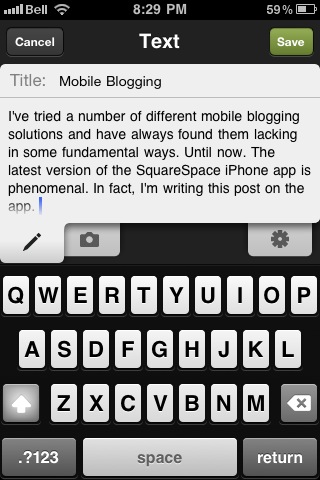
I've tried a number of different mobile blogging solutions and have always found them lacking in some fundamental ways. Until now. The latest version of the SquareSpace iPhone app looks really promising. In fact, I'm writing this post on the app. I just took a screen shot of the editing user interface and added it as image to this post. I also just entered the image editing mode but all I could do with the picture is to delete it. The text editing tab is great as are the post saving options (save to the iPhone, save as draft to the site, and save and publish to the site).
One other really valuable feature of the new version is comment management. The app also has a notification feature for comments which is incredibly useful for a blogger like me who has turned on comment moderation which requires me to explicitly approve comments. You may recall that I had to turn that on given the number of spam comments I was getting.
All in all, a really promising app, assuming of course that the post I just wrote here publishes properly with the image imbedded.
<Please note that I had to fix the size and the positioning of the image outside of the mobile app so the app a really good but not yet perfect>
A New User Experience Bar for OSs
Much of the discussion regarding the user experience improvements with modern SmartPhones and tablets focuses on the touch interaction with and graphically rich rendering of the user interface. I've also pointed out here the dramatic improvement in installing applications on these devices, typically with a single click on one button. All of these are of course significant improvements. However, I just experienced another phenomenal improvement in these devices (at least those built by Apple) with regard to restoring the system. I was recently advised by Apple to restore my iPhone. It sounded to me like the advice I often hear on tech podcasts and also from PC company support staff. I dreaded having to backup all the data then reinstall the operating system and then reinstall all the apps, copying back the data, changing back settings/passwords, etc.
focuses on the touch interaction with and graphically rich rendering of the user interface. I've also pointed out here the dramatic improvement in installing applications on these devices, typically with a single click on one button. All of these are of course significant improvements. However, I just experienced another phenomenal improvement in these devices (at least those built by Apple) with regard to restoring the system. I was recently advised by Apple to restore my iPhone. It sounded to me like the advice I often hear on tech podcasts and also from PC company support staff. I dreaded having to backup all the data then reinstall the operating system and then reinstall all the apps, copying back the data, changing back settings/passwords, etc.
I pressed the "Restore" button on iTunes to restore my iPhone and waited. After it was done and I looked at my iPhone, I was absolutely shocked. Everything was back to normal, all apps, all data, all settings, all preferences, everything! I was delighted. I think this is the new user experience bar for restoring all operating systems. This is how it should be done everywhere. Period.
Mobile Design Innovation
I heard the buzz about a new iPad app called Flipboard a few days ago so downloaded it to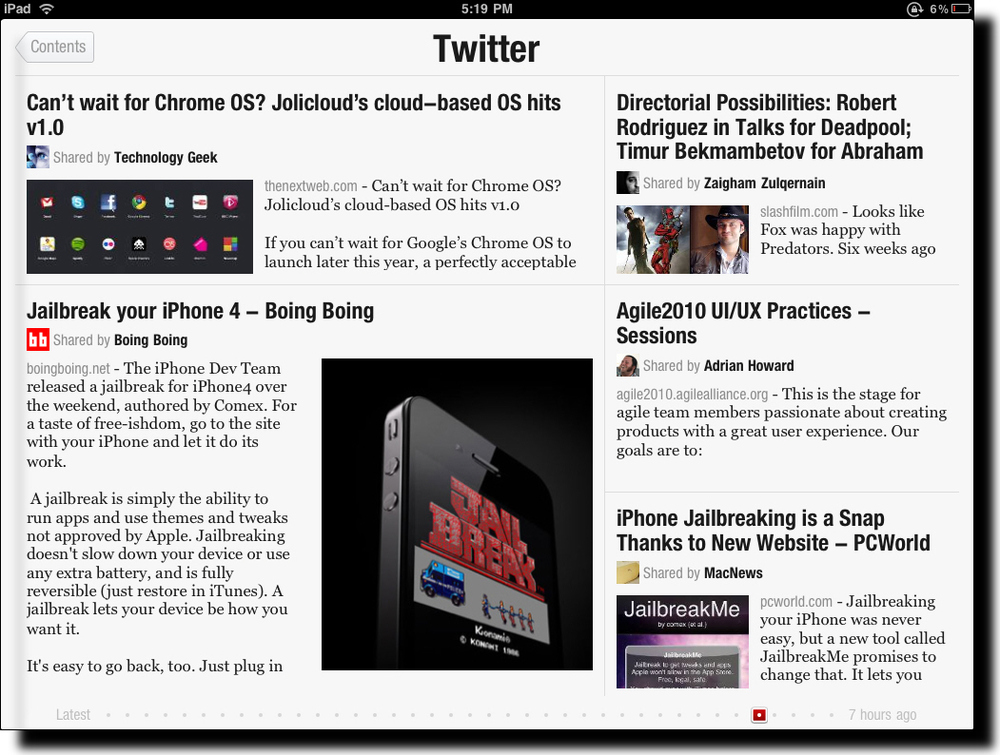 see what all the talk was about. Due to its popularity, the company could only make some of the capability of the app available upon download and the remainder, Twitter and Facebook integration, after a day or two. I knew immediately when the app launched that I was experiencing something entirely different. The splash screen shows full screen photos with a slow animation cross the screen of highlights from the various content sources you've selected. This approach to splash screens is novel and immediately grabs the user's attention with directly relevant content using often stunningly good photographs. Please note we're not even really using the app yet but have been drawn into it in an amazingly engaging way.
see what all the talk was about. Due to its popularity, the company could only make some of the capability of the app available upon download and the remainder, Twitter and Facebook integration, after a day or two. I knew immediately when the app launched that I was experiencing something entirely different. The splash screen shows full screen photos with a slow animation cross the screen of highlights from the various content sources you've selected. This approach to splash screens is novel and immediately grabs the user's attention with directly relevant content using often stunningly good photographs. Please note we're not even really using the app yet but have been drawn into it in an amazingly engaging way.
After you swipe to the left across the screen, you see the main Flipboard content channels. There is a starter set of content sources but you can select whichever ones you'd like from a fairly long list of candidates, including Wired, The New York Times, Fast Company, The Economist, Nature, Engadget, and The Onion.
Two special sources are Facebook and Twitter. These are the ones that you need to request access to during the early days of the launch of the app. Once you get your copy of Flipboard activated you now get content directly from your Facebook and Twitter streams into Flipboard.
So, what's so new you say, other than the cool photo splashscreen other than the fact that this app aggregates content from a number of different sources into one place? There are other apps that do that already and I've used most if not all of them.
What's truly unique about Flipboard is its design. It seamlessly integrates and visually renders content into in a way that Steve Jobs would call magical. Take a look at the screen shot above. Looks like a magazine layout, doesn't it? A layout that a designer would have manually crafted with photos included for appropriate emphasis of certain aspects of stories, etc. What you're actually looking at in that screen shot is my Twitter stream. Twitter is usually quite stark with textual tweets, links, and the occasional image. Flipboard has designed and coded algorithms to handle the layout and rendering of content dynamically and automatically. And the results are amazing. The user also has the option to tap on a story (actually a Tweet but it feels like a story) to see more detail as well as to be able to tap on any images to see them in full screen mode. You've never seen the images in your Twitter stream, Facebook updates, or from your online news sources look better! The subtle animation effects are also very effective.
It is often said that the spreadsheet program Lotus 1-2-3 was the "killer app" that drove the early success of the PC industry. I believe that Flipboard will do the same for the iPad and like devices. It shows was it possible with the device and its user interface patterns will likely (and should) be used widely in mobile apps like this. The app isn't without controversy, however, due to the way it pulls content from sources but I hope that this won't hamper the success of this amazing app. I should give you one caution, though. The app is so engaging to use that you'll find yourself spending much more time with it than you planned. It's like the experience you have with games except that in this case you're actually learning a ton during that extra time.
New Commenting Hurdle
I first started blogging on October 17, 2006 and initially turned on open commenting. Most blogs and sites did that around that time. The idea was to encourage open communication between the person writing the blog and anyone who wanted to write a comment. By 2007, I was getting spam comments on the blog so turned on moderated commenting. That turned out to take a fair amount of time moderating the comments and it also led to questions from users who wondered where their comment had gone. By February 2009, I turned on open commenting again to see how that would work this time around. The plan was to allow direct commenting and publishing the comments automatically but for me to spend some time once every several weeks to moderate comments after the fact. The problem is that there have been have been a surprising number of spam comments. So much so that I've decided to turn on limited moderated commenting.
sites did that around that time. The idea was to encourage open communication between the person writing the blog and anyone who wanted to write a comment. By 2007, I was getting spam comments on the blog so turned on moderated commenting. That turned out to take a fair amount of time moderating the comments and it also led to questions from users who wondered where their comment had gone. By February 2009, I turned on open commenting again to see how that would work this time around. The plan was to allow direct commenting and publishing the comments automatically but for me to spend some time once every several weeks to moderate comments after the fact. The problem is that there have been have been a surprising number of spam comments. So much so that I've decided to turn on limited moderated commenting.
I had a look around and found out that most sites actually use some form of moderated commenting. The key news sites and tech blogs use this. The only exceptions appear to be sites like YouTube and I've been finding the comments are the worst part of YouTube. The ratio of thoughtful and valuable comments to sheer crap is like 1 to 50. I find unfortunate that virtually everything that is made available has to either be gamed for a cheap buck or taken over by fools.
Please let me know if the change in the commenting system is too much of a hurdle (note that the photo of a hurdle shown above is courtesy of Fanboy30 via Creative Commons license.)
Apple Design vs. User Error
I've been thoroughly enjoying the use of my iPhone as regular readers of this blog will know from my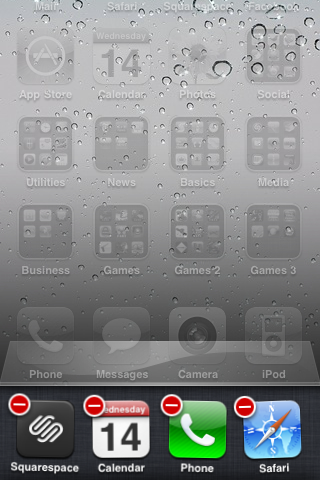
I do have first-hand experience with the new version of the operating system, iOS4, running on my iPhone 3GS. Since installing the new OS, my phone had been operating strangely: it would die even though it had a full battery charge, spontaneously reboot, and crash apps while I was using them. I was heart-broken that my wonderful iPhone had now developed some fatal flaw and the device that I could trust to always work now would be as unreliable as previous devices I'd used were.
A friend suggested I take it into an Apple store to have a Genius check it out. I did that. What I learned absolutely shocked me. The Genius ran a diagnostic program which reported a lack of available RAM. On further investigation it was determined that the lack of available RAM was due to multitasking. I haven't used multitasking much but was surprised to learn that many of the 100 or so apps I have on my iPhone were still running, albeit in suspended mode in most cases. Turns out that I didn't have the appropriate user model for the way multitasking works on the iPhone. I wonder how many users share my confusion. Here's actually how Apple designed multitasking to work. Every app you launch until you reboot is running in multitasking mode - and taking up memory! Guess how you're expected to stop apps from multitasking and taking up memory? You have to get into delete mode and delete by press the minus sign on every app in the multitasking tray! (see the screen capture above) Apparently, Steve Jobs when announcing iOS4 said something to the effect of companies who's multitasking operating systems require a task manager (meaning Microsoft's Windows) has failed to do its job. Well then, Apple has failed to do its job because not only is the multitasking tray on the iPhone a task manager, it requires you to manually delete every app you want to stop running on your device! If I could disable multitasking I would. Now I have to spend time manually deleting apps or reboot regularly both of which are a waste of time. I sure hope that the maintenance release of iOS4 fixes this problem and the one that iPhone 4 users are experiencing.
Apple is known for brilliant design but due to its intensely secretive culture, it doesn't do much user testing. It seems to me that the problems with the iPhone 4 and the problem I've identified here with the design of iOS4 may have been a casualty of this culture. I'd appreciate any thoughts you may have on this.
Length of Podcast Episodes
I ask for feedback on my podcasts on a regular basis in order to further improve them. One recurring theme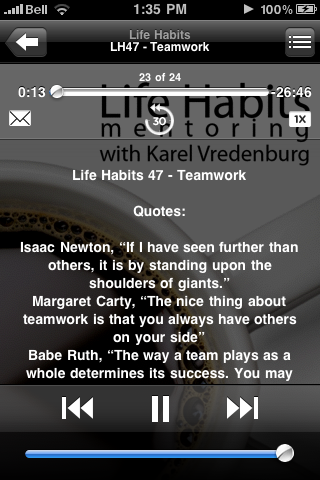
Going Digital for Free
Many aspects of our lives have been going digital over the past few years. A typical knee-jerk response to a question is to simply Google it. I consider Google an appliance for my brain given how often I use it in this way. The majority of people now listen to music in the form of MP3s using an iPod, iPhone, or some other personal audio device. Many also watch digital movies on their computer screens or increasingly on their TV screens too. News is increasingly consumed in digital form via websites, blogs, Twitter, Facebook, or podcasts. Books are now often read on dedicated devices such as a Kindle or directly on devices like iPhones and iPads and alternatively listened to as audio books in the way that music is listened to.
to a question is to simply Google it. I consider Google an appliance for my brain given how often I use it in this way. The majority of people now listen to music in the form of MP3s using an iPod, iPhone, or some other personal audio device. Many also watch digital movies on their computer screens or increasingly on their TV screens too. News is increasingly consumed in digital form via websites, blogs, Twitter, Facebook, or podcasts. Books are now often read on dedicated devices such as a Kindle or directly on devices like iPhones and iPads and alternatively listened to as audio books in the way that music is listened to.
I'm an early adopter of most things digital and have consumed content almost exclusively in digital form for the past few years. I've been paying for much of this digital content though whether through iTunes for music and movies, audible.com for audio books, and amazon.com for eBooks. I was reflecting the other day on the fact that I used to borrow books, music, and movies from the public library, the physical versions of these things. I thought it was an amazing tax-supported way of simply borrowing media for the time period you needed it. I remember checking periodically with the library to see if they were moving into the digital world and was routinely disappointed to learn that they weren't. In fact, I found it extremely frustrating that I couldn't even access the online catalog because all the computers were being used by people accessing their email!
You can imagine my delight when I recently checked with my public library website and found that they now provide digital media and the ability to download and transfer it directly to your media device (an iPhone in my case). The media stays on your device for the loan period and automatically disappears after that leaving you extra space on your device. They offer music, movies, ebooks, and audio books. Since finding this new free resource about a couple of weeks ago, I've already listened to four audio books. I'd recommend that you check out your local public library website to see if yours has digital content for download as well.
Optimizing Teamwork
Most of what we do at work and at play is done with other people. However, little attention is often paid to enhancing what we do with others in teams. There is certainly lots of attention on how to improve the performance of sports teams but that isn't the case for other teams in work and educational settings. A listener of my Life Habits podcast series sent me a question on this topic. She used to be an Olympic athlete in a non-team sport and was now retired from sports and needing to learn how to work effectively and optimally on teams at work. I gave that some thought and came up with a list of ten ideas to consider in enhancing and optimizing the workings of teams. I recorded a podcast episode on the topic which you can listen to via the Life Habits iTunes page or via the web at the Life Habits show notes site. I would appreciate any thoughts you may have on the episode and the ideas discussed in it. (the photograph on the right is courtesy of Ingorrr via Creative Commons license)
of sports teams but that isn't the case for other teams in work and educational settings. A listener of my Life Habits podcast series sent me a question on this topic. She used to be an Olympic athlete in a non-team sport and was now retired from sports and needing to learn how to work effectively and optimally on teams at work. I gave that some thought and came up with a list of ten ideas to consider in enhancing and optimizing the workings of teams. I recorded a podcast episode on the topic which you can listen to via the Life Habits iTunes page or via the web at the Life Habits show notes site. I would appreciate any thoughts you may have on the episode and the ideas discussed in it. (the photograph on the right is courtesy of Ingorrr via Creative Commons license)
Design Guidelines and Trade-offs
Design guidelines and design trade-offs are often hotly debated in design circles. However, very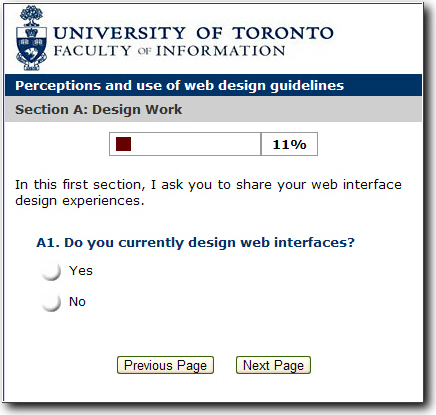 little is know about them in actual practice. Now a doctoral student, Steve Szigeti, is doing research on this very topic. Steve is a doctoral candidate at the Faculty of Information (iSchool) at the University of Toronto, as well as a graduate fellow in the Knowledge Media Design collaborative program at the university. I'd like to share Steve's invitation for you to participate in his study here. Here are his words:
little is know about them in actual practice. Now a doctoral student, Steve Szigeti, is doing research on this very topic. Steve is a doctoral candidate at the Faculty of Information (iSchool) at the University of Toronto, as well as a graduate fellow in the Knowledge Media Design collaborative program at the university. I'd like to share Steve's invitation for you to participate in his study here. Here are his words:
I'm seeking your help in a research study which looks at the role of design guidelines and design trade-offs in the process of web interface design. I would be grateful if you could share your opinions and experiences in a web based questionnaire. The questionnaire takes roughly 15-20 minutes to complete. All of your responses will remain confidential. This study is part of doctoral research in the Faculty of Information (iSchool) at the University of Toronto. I am interested in the experiences you and other web interface designers have with aspects of the design process, such as the use of guidelines and your experiences (if any) with design trade-offs. In appreciation for your participation, aggregate results of the survey will be posted at http://www.szigeti.ca after September 1, 2010. If you would like more information about this study, please don’t hesitate to contact me.
Please contribute to Steve's study by taking this questionnaire. Thanks.
Apple's New iOS4
I just upgraded my iPhone to the new version of the operating system. Apple renamed what used to be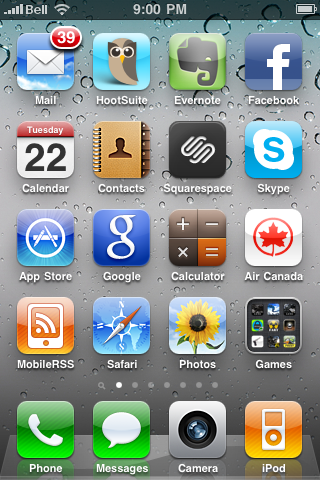
The major enhancements that come with iOS4 include multitasking, folders, integrated and threaded mail, and camera zooming. Let's explore each of these in turn.
Multitasking is a welcomed addition to the iPhone. The method of switching between apps once you know that you have to double-press the button is pretty intuitive and convenient. What isn't so intuitive is what this control actually does. The tray of running apps is obvious enough but what is confusing is the fact that that tray just keeps filling up with apps even if you closed them down by single pressing the button. The only way to remove apps from the actively running tray appears to be to explicitly delete them, which is weird. Apparently, only a few apps are able to actually keep running whereas others simply suspend their state while not in focus. Any difference between these two types of apps in terms of their multitasking ability isn't apparent in the user interface itself.
Folders are not only a nice to have but a necessity if you have a reasonably large collection of apps. The user interface action in this case isn't intuitive but once you've done it once, it does feel natural. You have to simply drag one app icon onto another and a folder is created with the default name of the category of the apps. You can then add up to 12 apps per folder. Rather than having to scroll to the right and left through many pages of apps, the new folders allow you to simply tap on a folder which reveals all the apps within it without having to do any scrolling. I've found this a perfect way of cleaning up the apps on my iPhone and being able to access them in a much more efficient manner.
Mail has been enhanced with the addition of an integrated inbox and threaded conversations. I'm not crazy about the integrated inbox because I personally don't want my work and personal email in a single inbox. I find it jarring. However, others may think it is a great feature. As for the threaded conversations, I can't find them. I don't know if you have to somehow turn this feature on through another hidden user interface action but I don't see any threading in my inboxes. I'm assuming that the feature is essentially the approach that Google introduced into its GMail system where all replies to an initial email are nested together. I use that all the time in GMail and in Lotus Notes but I don't see it in my iPhone inboxes. When I find it, I'll report back here what I think of it.
Camera zooming is an incredibly important addition to the iPhone. I take pretty well all my pictures with the iPhone and the other day I was taking pictures of my daughter and her friends at a pre-prom party we hosted at our house. For some of the pictures, we had the group of friends all line up on the other side of the swimming pool from the parents taking pictures. The parents with actual cameras were able to zoom in to capture the group of friends across the pool but I wasn't able to zoom at all and, as a result, missed some of the detail. I now can with the updates made to the camera which allows you to move a slider on the camera view to set the right level of zoom. Pretty sweet!
While my very early experiences with the enhancements made to iOS4 weren't unqualifiedly positive, I am still very pleased with the update and especially so given the price - free.
iPad - Design without Affordance
I've now had a lot more experience with the iPad. I continue to thoroughly enjoy using it. However, I'm going through a similar experience that I went through (and blogged about here) with my iPhone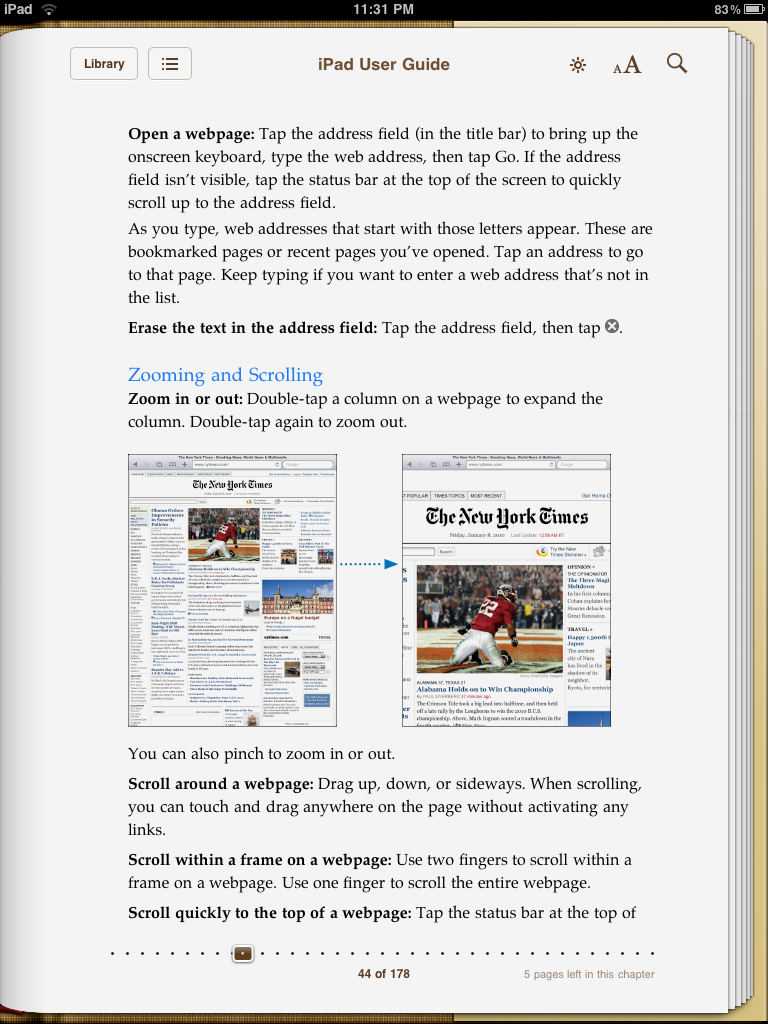
It was colleague of mine that finally clued me into the solution - the two finger swipe. I just tried it tonight and it worked! While I'm glad that I now know how to do something that is pretty basic on the iPad, it got me thinking about Apple's overall strategy of designing without affordances. The overall assumption is that the various touch actions are intuitive and, as a result, it is so much more efficient to not clutter screens with affordances like scroll bars. To Apple's credit, most of the touch actions are intuitive. However, the problem is the set of touch actions that are not intuitive and how users are supposed to find out about them. I admire Apple's commitment to its design principles for virtually all other aspects of the design of this device but that purity of adherence to the principles does have its costs and this is one of them.
iPad - A New Paradigm in Computing
I was tempted to write a post shortly after I got my iPad but thought better of it. I wanted to use the iPad everyday for several weeks before summarizing my experience. My overall conclusion is that the iPad truly represents a new paradigm in computing. It's a game changer. I've written on this blog for years that advances in operating systems that were touted by others as being significant, like Windows 7 and OSX Snow Leopard, were really tweaks on a decades old system. The iPad is a true departure from this operating system heritage. It's a resetting of the dial. It's what's called "clean-sheet" design in the industry - not worrying about backward compatibility and consistency with prior systems.
iPad everyday for several weeks before summarizing my experience. My overall conclusion is that the iPad truly represents a new paradigm in computing. It's a game changer. I've written on this blog for years that advances in operating systems that were touted by others as being significant, like Windows 7 and OSX Snow Leopard, were really tweaks on a decades old system. The iPad is a true departure from this operating system heritage. It's a resetting of the dial. It's what's called "clean-sheet" design in the industry - not worrying about backward compatibility and consistency with prior systems.
I believe that Apple had a vision for the iPad when they designed the iPod Touch and the iPhone. By the way, I don't think they planned the evolution of the non-touch iPods as carefully since the information architecture broke several times throughout that product family transition. It was different with the touch line of products. I think they were planned as a transition. Introducing a phone with touch capability was revolutionary but it also set the stage for the later introduction of the iPad so that everyone was already comfortable interacting with a touch device. You can use the iPad the moment you turn it on partly because you've experienced an iPhone or iPod Touch before (or any of the other manufacturer's products that have copied the interaction design). Interestingly, though, the iPad feels quite natural to those who haven't had experience with a touch device previously. The actions are generally so natural and obvious that it leads truly to a walk up and use experience.
Here are the things that I think are key to the new computing paradigm that the iPad is introducing.
- Instant On - while other computers need to boot up even if they're coming off a sleep state, the iPad comes on as fast as you can swipe your finger to unlock the screen. It's amazingly fast - essentially instant. This is a game changer because the iPad becomes the device of choice when you want to quickly check your e-mail, an app, or a website.
- Convenient Portability - while notebook computers and netbooks are portable in that you can carry them around, you still have to use them like a computer; similarly, smartphones are portable too but are too small to do any number of activities that require a larger screen and keyboard. The iPad has the ideal form factor to conveniently access and interact with information.
- Simplicity - while other operating systems make a user figure out a file system, the concept of an application that works with files in the file system, left and right mouse clicks, click and drag, and such esoteric things as drivers, settings, and the need to download, install, and configure applications, the iPad simply has apps which you can get by pressing a button called "Install App" and an interface that mostly works like you would expect it would if you were using an analogue version of the thing (flip the page in a book by placing your finger on the page and pushing it.)
The iPad at my house is used by anyone who needs quick access to content, for watching movies personally, and for using doing school projects. I should point out that since I got the iPad in Canada before it was available in Canada, my access to the App Store has been problematic. Initially, the App Store wouldn't load at all and it would after I created a US account but then I could only download free apps because I needed a US credit card in order to buy paid apps. I now know about the latest fix to even be able to buy apps in the US store but haven't gone through the laborious steps to do that. It has been frustrating working with the iPad given these conditions and it has also meant that I haven't been able to use higher-end productivity apps to further test the iPad experience.
There are some limitations that I've experienced. The glare of the screen is problematic in bright light conditions but I use mine indoors mostly so this isn't a problem very often. The lack of printing support may become a problem once I use higher-end apps. The lack of a camera is a problem in trying to use the iPad for Skype calls but a recent Camera for the iPad app appears to have partially solved the camera problem. I find the lack of multitasking a problem in only certain situations and I suspect the 4.0 version of the OS will address this issue. The major problem I've experienced thus far has actually been the inconsistency in the user interface design of the apps on the iPad. Apple appears to have approved some of these apps too quickly in order to fill out the App Store for the launch and I hope they'll review apps more carefully in the future.
I'll provide another review in time when I get direct access to my country's App Store and then use more sophisticated apps. All in all, my impression from a few weeks of using the iPad is that it represents the first in a new paradigm of computing.
Is Web Media Ready for Prime Time?
I've been listening to podcasts for years and currently subscribe to a total of 32 podcast series. As you know, I also create two podcasts myself. I think that I'm hooked on this type of media. As most people do, I prefer my podcasts in audio format because I'm usually doing something else with my eyes while listening to podcasts like driving, running, or doing the dishes. I still subscribe to video podcasts but mostly listen to the audio track only. I occasionally find that I need to turn on my iPhone to view the video when video is critical to the subject matter. This usually happens on TED.com Talks and sometimes on GeekBrief.TV. I listen to practically all of the podcasts on Leo Laporte's This Week in Tech (TWIT) podcast network but rarely even feel the need to watch the video. I occasionally turn on the video to see what a new guest looks like but that's about it. Leo is a real pioneer and tends to push the technology envelop and is usually successful with it. He's one of only a few professional podcasters making good money in the field. His latest push is into streaming video and making video podcasts and YouTube replays available. Others that have done this have adopted the a studio model and while still relatively informal, still making the video content look professional. Leo, on the other hand, makes video available but up until the last week hasn't paid any attention to the professionalism of the video stream content. Shown in the picture here is a regular guest on the flagship TWIT show. Having a massive microphone dangling right in front of the guest's face isn't perhaps the best way to produce web-based video content. Leo and his other guests also usually wear large headphones. So, my vote thus far is that although it is technically possible to create video content on the web, those producing it aren't quite ready for prime time. The last episode of the TWIT show did include a discussion of smaller microphones but there wasn't any mention of not having them cover the guest's face nor any discussion of getting rid of the headphones in favor of the discrete ear buds used on TV which I also use when I use video conferencing at work. I should point out that there are video podcasts that have good production values and, thus, are ready for prime time. However, the most popular tech podcast network doesn't yet appear to be.
know, I also create two podcasts myself. I think that I'm hooked on this type of media. As most people do, I prefer my podcasts in audio format because I'm usually doing something else with my eyes while listening to podcasts like driving, running, or doing the dishes. I still subscribe to video podcasts but mostly listen to the audio track only. I occasionally find that I need to turn on my iPhone to view the video when video is critical to the subject matter. This usually happens on TED.com Talks and sometimes on GeekBrief.TV. I listen to practically all of the podcasts on Leo Laporte's This Week in Tech (TWIT) podcast network but rarely even feel the need to watch the video. I occasionally turn on the video to see what a new guest looks like but that's about it. Leo is a real pioneer and tends to push the technology envelop and is usually successful with it. He's one of only a few professional podcasters making good money in the field. His latest push is into streaming video and making video podcasts and YouTube replays available. Others that have done this have adopted the a studio model and while still relatively informal, still making the video content look professional. Leo, on the other hand, makes video available but up until the last week hasn't paid any attention to the professionalism of the video stream content. Shown in the picture here is a regular guest on the flagship TWIT show. Having a massive microphone dangling right in front of the guest's face isn't perhaps the best way to produce web-based video content. Leo and his other guests also usually wear large headphones. So, my vote thus far is that although it is technically possible to create video content on the web, those producing it aren't quite ready for prime time. The last episode of the TWIT show did include a discussion of smaller microphones but there wasn't any mention of not having them cover the guest's face nor any discussion of getting rid of the headphones in favor of the discrete ear buds used on TV which I also use when I use video conferencing at work. I should point out that there are video podcasts that have good production values and, thus, are ready for prime time. However, the most popular tech podcast network doesn't yet appear to be.
The Rush to HTML5 Video
Anyone who ever questioned the market power of Apple and specifically, Steve Jobs, just has to have a look at large websites right now. Most web-based video and audio used to be delivered with the use of Adobe's Flash player or some other Flash-based control. However, Steve Jobs has never allowed Flash on the iPhone or the iPod Touch and, of course, it also doesn't appear on the iPad either. In fact, Jobs recently confirmed that it will never appear on these devices. What effect has this had? The realization that they may be excluding this large and increasing market with their sites, has led most sites to implement alternatives. The alternative is, in fact, to use the draft html5 standard. What's interesting about this trend is that some sites that aren't quite there yet with their html5 implementation are essentially apologizing for it. I just wanted to watch something on Ustream on my iPhone and was greeted with the message that "Currently this video is only viewable in Flash :( We're working hard to make all content viewable on both the iPad and iPhone, please check back later!" Now, that's market power.
look at large websites right now. Most web-based video and audio used to be delivered with the use of Adobe's Flash player or some other Flash-based control. However, Steve Jobs has never allowed Flash on the iPhone or the iPod Touch and, of course, it also doesn't appear on the iPad either. In fact, Jobs recently confirmed that it will never appear on these devices. What effect has this had? The realization that they may be excluding this large and increasing market with their sites, has led most sites to implement alternatives. The alternative is, in fact, to use the draft html5 standard. What's interesting about this trend is that some sites that aren't quite there yet with their html5 implementation are essentially apologizing for it. I just wanted to watch something on Ustream on my iPhone and was greeted with the message that "Currently this video is only viewable in Flash :( We're working hard to make all content viewable on both the iPad and iPhone, please check back later!" Now, that's market power.
Are iPad Apps too Expensive?
We used to pay hundreds of dollars for games and other consumer software. Apple changed all that with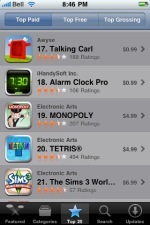 the introduction of apps in iTunes for the iPhone, iPod Touch, and now the iPad. The typical price of an app was in fact free and paid apps had prices of $0.99 and apps going for $4.99 and $6.99 were considered expensive. I hear complaints now that iPad apps are way too expensive at $10 and this from people who make good money and think nothing of buying a coffee or a drink for that amount. Is this a case of Apple having been too successful at resetting our perception of price? With the announcement of iPhone OS 4.0 with its iAd platform, is Apple trying to reset the app price back to free and have app developers and Apple itself make money solely from advertising? Is everyone thinking that advertising is the only monetization strategy based on Google's success with it? Twitter even thinks so with their recent announcement, right? I prefer to buy my apps and think that I'm getting really good value if I get a really good game for $10. Remember that games on any other platform cost several fold that amount at least. What's your experience with this? I'd appreciate any thoughts you may have on this.
the introduction of apps in iTunes for the iPhone, iPod Touch, and now the iPad. The typical price of an app was in fact free and paid apps had prices of $0.99 and apps going for $4.99 and $6.99 were considered expensive. I hear complaints now that iPad apps are way too expensive at $10 and this from people who make good money and think nothing of buying a coffee or a drink for that amount. Is this a case of Apple having been too successful at resetting our perception of price? With the announcement of iPhone OS 4.0 with its iAd platform, is Apple trying to reset the app price back to free and have app developers and Apple itself make money solely from advertising? Is everyone thinking that advertising is the only monetization strategy based on Google's success with it? Twitter even thinks so with their recent announcement, right? I prefer to buy my apps and think that I'm getting really good value if I get a really good game for $10. Remember that games on any other platform cost several fold that amount at least. What's your experience with this? I'd appreciate any thoughts you may have on this.
The iPad that isn't - for me
Technology media is centered in the US. As a result, anyone reading the tech press or even the popular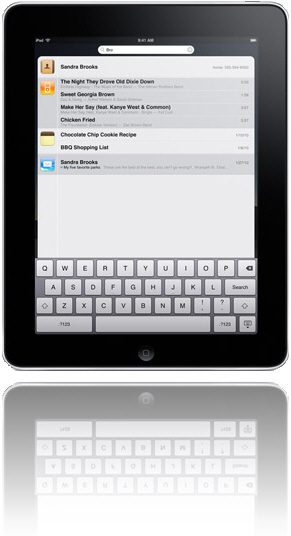 press who take the lead from the tech press would be of the impression that Apple released a new and exciting product on April 3rd and that users everywhere love it. There's one small detail missing from this picture and that is that the product, the iPad, has only been released in the US. When I tweeted about and discussed the iPad on Facebook, several of my American friends were surprised to learn that they were among the select few (if you can call 500 thousand few) in the world who were able to buy an iPad. I was at my local Apple store on April 3rd to buy replacement earbuds but was surprised to see many more than usual customers in the store. When I asked a staff member, he said that there had been lines out the door earlier of people who thought they could buy the much talked about iPad in Canada.
press who take the lead from the tech press would be of the impression that Apple released a new and exciting product on April 3rd and that users everywhere love it. There's one small detail missing from this picture and that is that the product, the iPad, has only been released in the US. When I tweeted about and discussed the iPad on Facebook, several of my American friends were surprised to learn that they were among the select few (if you can call 500 thousand few) in the world who were able to buy an iPad. I was at my local Apple store on April 3rd to buy replacement earbuds but was surprised to see many more than usual customers in the store. When I asked a staff member, he said that there had been lines out the door earlier of people who thought they could buy the much talked about iPad in Canada.
So, what's going on here? I fully understood that the iPhone had to be delayed worldwide because it involved special arrangements with cell/mobile phone companies in each country. However, that isn't the case with the iPad, at least not the WiFi version that is the only version that is available now in the US. While the user experience is amazingly superior to that of a computer, the basic componentry makes it no different than a computer for the purposes of worldwide release. I don't get it. And, I can't get it, an iPad that is, for another few weeks. There is no firm date nor price yet. Very frustrating for customers wanting to spend their money with a company that is so confident that they will that the company can disregard their worldwide market.
Frequency of Podcasts
I've been a podcaster for more than two years now, producing the UXDesignCast and Life Habits podcast series. I've often wondered at what frequency listeners would like to have the podcast delivered. My ideal frequency, and the frequency I like to receive the podcasts I listen to, is weekly. I listen to a lot of podcasts in a week and typically get through them all in the week. I get a fair bit of feedback from listeners, especially from those who listen to the Life Habits series. Of the feedback that concerns the frequency of episodes, listeners who write in generally ask for more frequent delivery of them. Of course, it could be the case that the people who write in are into the podcast the most and, as a result, want more episodes faster. Podcast download statistics aren't really much use in this regard because subscribers have the episodes delivered to them automatically as soon as they become available and it isn't possible to know when they actually listened to the episodes that were downloaded. I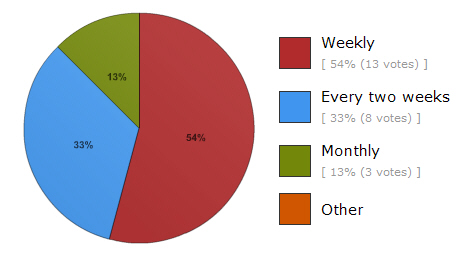 therefore decided to put up a quick poll to ask the question, "How frequently would you like to have podcast episodes made available?" with the response alternatives of "weekly", "every two weeks", "monthly", and "other". The results indicate that 54% of respondents prefer weekly episodes, 33% every two weeks, and 13% monthly. So, the vast majority of 87% would like to have episodes within a two week period and the majority of those prefer them to appear weekly. This tells me that I should continue to try to deliver on a weekly basis but, if circumstances prevent that and an episode comes out in two weeks, it will still satisfy most listeners. Of course, I do target putting out weekly episodes, particularly for my Life Habits podcast series. I'll continue to do that then and will try to increase the frequency of the UXDesignCast ones as well. Of course, feel free to provide any additional feedback you may have on this via the comment feature of this site.
therefore decided to put up a quick poll to ask the question, "How frequently would you like to have podcast episodes made available?" with the response alternatives of "weekly", "every two weeks", "monthly", and "other". The results indicate that 54% of respondents prefer weekly episodes, 33% every two weeks, and 13% monthly. So, the vast majority of 87% would like to have episodes within a two week period and the majority of those prefer them to appear weekly. This tells me that I should continue to try to deliver on a weekly basis but, if circumstances prevent that and an episode comes out in two weeks, it will still satisfy most listeners. Of course, I do target putting out weekly episodes, particularly for my Life Habits podcast series. I'll continue to do that then and will try to increase the frequency of the UXDesignCast ones as well. Of course, feel free to provide any additional feedback you may have on this via the comment feature of this site.
